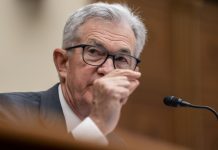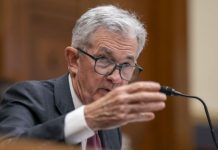
June 15 (UPI) — Amid persistent concerns about rising costs in the United States, the Federal Reserve on Wednesday concluded a two-day policy meeting and did something it hasn’t done in almost 30 years — hike key interest rates by 3/4 of a point.
The move was widely expected by most analysts and is seen as a necessary measure to get a better handle on rising inflation.
The last time the central bank increased rates by 3/4 of a point was 1994 — just before the U.S. economy boomed for the remainder of the 1990s.
When the Federal Reserve raises rates, it usually does so in quarter-point increments. But with consumer inflation rising at an annual rate of about 8.6%, which is far above the Fed’s target range, analysts said the central bank has to be aggressive. The Fed increased rates by a half-point at its last policy meeting in early May, which was its largest increase since 2000.
Too much consumer spending combined with other market conditions can cause inflation to rise. By increasing interest rates, the Fed is attempting to get Americans to borrow less, lower demand and freeze prices.
Fed Chairman Jerome Powell will speak about the increase at a news conference at 2:30 p.m. EDT.
Goldman Sachs this week adjusted its forecast and said it expected .75% hikes on Wednesday and at the Fed’s next policy meeting in July, followed by a half-point increase in September. From there, the Fed will make quarter-point hikes in November and December, the investment bank projected.
That would raise the federal funds rate to between 3.25% and 3.5% by the end of 2022. With Wednesday’s hike, the rate is between 1 1/2% and 1 3/4%.
Powell expressed some optimism in March about a “soft landing” for the recovering economy, which has been disrupted by COVID-19 and the Russian war in Ukraine. Energy prices, notably gasoline, have been the primary driver of inflation over the past several months.
“I believe that the historical record provides some grounds for optimism: Soft, or at least soft-ish, landings have been relatively common,” Powell said at the time.
In 1994, then-Fed Chairman Alan Greenspan achieved a soft landing when interest rates reached 6% over seven rate hikes — including two half-point increases and a 3/4-point increase to stem inflation after a recession in the early 1990s.
Some economists note, however, that Greenspan proactively raised rates to get ahead of inflation, while Powell has mostly been reactionary. Greenspan was also aided by a robust workforce as baby boomers entered the pinnacle of their careers and immigration numbers were strong. Today, Powell faces a different workforce that’s been whittled down by the COVID-19 pandemic.
“In the past, when you’ve pushed up the unemployment rate, you’ve almost never been able to avoid a full-fledged recession,” former New York Federal Reserve Bank President Bill Dudley told CNN. “The problem the Fed faces is they’re just late.”
The national unemployment rate is historically low, at about 3.6%, the Labor Department said in its jobs report for May. After COVID-19 arrived in early 2020, the unemployment rate soared to more than 15%. Ten years ago, the unemployment rate was about 8%.
The full economic and inflationary outcome that will result from Wednesday’s rate increase, and the rate hikes for the rest of 2022, won’t be known for months.
The Labor Department said last week that consumer prices are up about 8.6% over the past 12 months. On Tuesday, it said producer prices — the cost of goods at the wholesale level, before they reach consumers — are up 10.8% since May 2021.
The Fed’s decision on Wednesday had an immediate impact on Wall Street. By 2:15 p.m., the Dow Jones Industrial Average was up about 140 points. The S&P 500 was up about 30 points and the Nasdaq composite had increased by almost 180 points.






